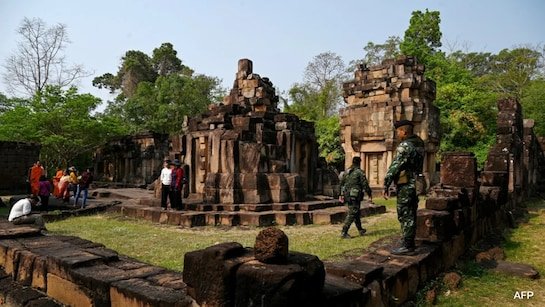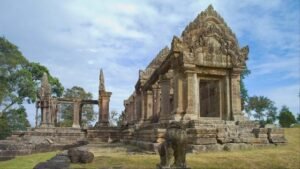Ancient stone ruins stand silently while two nations clash over their rightful ownership and control. The Hindu temples complex becomes a focal point where diplomatic tensions reach dangerous levels between neighboring countries. Your understanding of this dispute requires examining centuries of complex historical claims and modern political realities.
Historical Roots Behind The Temple Dispute
The Thailand-Cambodia conflict centers around magnificent temple complexes built during the Khmer Empire’s golden years. These sacred sites represent architectural marvels that showcase ancient Hindu religious traditions and artistic achievements. Dating back over 1,000 years, these structures hold immense cultural value for both nations involved.
Cambodia claims ownership based on historical evidence showing Khmer builders constructed these temples during their empire’s peak. Archaeological findings support Cambodian assertions about the sites’ origins and cultural significance throughout various historical periods. The temples reflect traditional Khmer architectural styles and Hindu religious symbolism that remains deeply meaningful today.
Thailand argues that border changes throughout history have placed these temples within their current territorial boundaries. Thai officials point to modern international agreements and legal documents supporting their sovereignty claims over disputed areas. The complex nature of colonial-era border demarcations adds further complications to resolving these competing territorial assertions.
The Preah Vihear Temple Complex Controversy
Preah Vihear Temple serves as the primary flashpoint where military tensions have escalated between these Southeast Asian neighbors. This UNESCO World Heritage Site sits atop a cliff along the contested border region between both countries. The International Court of Justice awarded the temple to Cambodia in 1962, but disputes continue over surrounding territory.
The temple’s strategic location provides commanding views across vast plains and offers significant military advantages to controlling forces. Both nations have deployed troops near the site, leading to armed clashes that have resulted in casualties. These confrontations demonstrate how ancient religious sites can become modern geopolitical battlegrounds with serious consequences.
Tourism revenue from the temple complex adds economic dimensions to this territorial dispute between Thailand and Cambodia. Millions of visitors annually generate substantial income for whichever nation controls access to these remarkable archaeological treasures. The economic stakes intensify political pressure on both governments to maintain their territorial claims.
Modern Political Tensions and Military Standoffs
Recent years have witnessed increased military buildups along disputed border areas where these ancient temples stand silently. Armed forces from both nations maintain heightened alert status while political leaders engage in diplomatic negotiations. Border skirmishes periodically erupt, threatening regional stability and peaceful coexistence between these neighbors.
Nationalist sentiments within both countries fuel public support for aggressive stances regarding temple ownership and territorial control. Political parties use these disputes to rally domestic support while demonstrating strength against foreign claims. Media coverage often emphasizes patriotic duty and historical rights rather than peaceful resolution strategies.
Key factors escalating tensions include:
- Military presence increases near disputed temple sites
- Cross-border artillery exchanges during peak conflict periods
- Diplomatic protests and formal complaints through international channels
- Domestic political pressure to defend national territorial integrity
- Economic competition for tourism revenue from heritage sites
The cluster of Hindu temples represents more than religious architecture; they symbolize national identity and historical legitimacy claims. Each nation views control over these sites as validation of their broader territorial sovereignty and cultural heritage.
International Mediation Efforts and Legal Frameworks
ASEAN member states have attempted mediating between Thailand and Cambodia to prevent further military escalation over temple disputes. Regional diplomatic initiatives emphasize peaceful negotiation and respect for international legal decisions regarding border demarcation. However, progress remains limited due to strong nationalist positions maintained by both governments.
The United Nations Educational, Scientific and Cultural Organization plays important roles in protecting these World Heritage Sites from damage. UNESCO officials express concerns about military activities near ancient temples that could threaten their structural integrity. International preservation efforts sometimes conflict with national security priorities of both competing nations.
World Court rulings provide legal frameworks for resolving territorial disputes, but enforcement mechanisms remain limited without mutual cooperation. The 1962 International Court of Justice decision favoring Cambodia’s claim over Preah Vihear Temple established important precedent. Nevertheless, Thailand continues challenging various aspects of that ruling and subsequent boundary interpretations.
Cultural Heritage Versus Political Sovereignty
These ancient Hindu temples represent shared cultural heritage spanning across modern national boundaries that emerged centuries after construction. The Khmer Empire’s influence extended throughout Southeast Asia, creating architectural legacies that transcend current political divisions. Both nations can legitimately claim connections to this remarkable historical and religious heritage.
Religious significance adds another layer of complexity to territorial disputes over these sacred sites dedicated to Hindu deities. Pilgrims and worshippers from various countries visit these temples for spiritual purposes regardless of political ownership questions. The universal religious value sometimes conflicts with narrow nationalistic claims about exclusive territorial control.
Path Forward for Peaceful Resolution
Diplomatic solutions require both nations to prioritize regional stability over nationalistic territorial ambitions regarding these ancient temple sites. Joint management agreements could allow shared custody and tourism development while respecting each nation’s cultural claims. Creative compromises might transform sources of conflict into symbols of peaceful cooperation between neighboring countries.
Economic cooperation through joint tourism promotion could benefit both Thailand and Cambodia while preserving these irreplaceable archaeological treasures. Shared revenue arrangements and coordinated conservation efforts would serve mutual interests better than continued military confrontation. The cluster of Hindu temples could become bridges connecting these nations rather than barriers dividing them.
International mediation and legal frameworks provide pathways for resolving territorial disputes through peaceful means rather than military force. Both countries stand to gain more through cooperation than continued conflict over these ancient religious sites.







Be First to Comment